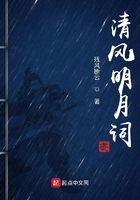1.In studying the great valley of the Amazon,the first step is to distinguish between the mainland and the flood-plain.The mainland is always beyond reach of the floods,though it may be only a few inches above them;and it has a foundation of rock,which crops out in many places.The flood-plain,on the contrary,has clearly been formed by the river itself.Its islands and flats are built up of mud and clay,with an occasionalsand-bank;but they are never stony,and only isolatedpoints are above the level of the highest floods.
2.When sailing among the islands and through the channels of the flood-plains,with their swampy forests,their great stretches of meadow,and their half-submerged plantations,any one who is not blind must feel his soul moved within him by the marvellous beauty of the vegetation.No ground is seen;straight up from the water the forest rises like a wall-dense,dark,impenetrable,a hundred feet of leafy splendour.
And breaking out everywhere from among the heaped-up masses rise the palm trees in thousands.For herethe palms hold court;nowhere else is their glor y unveiled as we see it here.If palms standing alone are esteemed the most beautiful of trees,what shall we say when their numbers are counted,not by scores or by hundreds,but by thousands,and where they are seen against a background of such forest as can never be found outside of the tropics?
3.The Indian pilot of our boat points out numbers of rubber-trees,and we learn to recognize their white trunks and shining bright-green foliage.This low region is one of the most important rubber districts,and hundreds of natives are employed in gatheringand preparing the crudegum.Occasionally we seetheir thatched huts along the shore,built on piles,andalways damp,reeking,dismal,suggestive of agueandrheumatism;for the tide-lowlands,glorious as theyappear from the river,are sodden marshes within.
4.The rubber-trees are scattered through marshy forests,where we clamber over logs,and sink into pools of mud,and leap the puddles;where the mosquitoes are bloodthirsty,and nature is damp and dark and threatening;where the silence is unbroken by beast or bird.
5.In the early morning,men and women come with baskets of clay cups on their backs,and little hatchets to gash the trees.Where the white milk drips down from the gashes,they stick their cups on the trunk with daubs of clay.If the tree is a large one,four or five gashes may be cut in a circle round the trunk.By noon the flow of milk has ceased,and the natives come tocollect the contents of the cups in calabashjugs.A gillor so is the common yield from each tree,and a single gatherer may attend to a hundred and twenty trees or more,wading through these dark marshes,and paying dearly for his profit in fever and weakness.
6.A day‘s gathering will be a calabash of white liquid,in appearance precisely like milk.If left in this condition,it coagulatesafter a while,and forms a whitish gum.
To make the black rubber of commerce,the milk must go through a peculiar process of manufacture.Over a smouldering fire is placed a clay chimney,like a wide-mouthed,bottomless jug;through this chimney the thick smoke rises in a constant stream from the fire beneath.Now the rubber-gatherer takes a mould like a round-bladed paddle,dips it in the milk,and holds it over the smoke until the liquid coagulates.
7.Then another coat is added;but now,as the wood is heated,the milk coagulates faster.It may take the gatherings of two or three days to cover the mould thickly enough.The rubber is still dull white ;but in a short time it turns brown,and finally almost black.The mass is then cut from the paddle and sold to traders in the village.Bottles are sometimes made by coating with rubber a clay mould,which can be broken up and removed.
8.During the wet months,from February until June or July,the ground is under water,and the huts of the natives are wholly deserted.The gum is then weak,and of comparatively little value.Besides,the trees need this period of rest to make up for the constant drain in summer.
1.The greater part of the land surface of the earth is thickly covered with growing plants.The influence of this plant covering is very important in many ways.The most immediate effect produced by trees is the improvement of the soil into which their rootspenetrate.Wherever they succeed in finding a foot-hold,they at once proceed to make and to preserve a coating of soil,which in the end may become fit for cultivation.
2.The roots penetrate downward into crevicesofthe rock,starting as slender filamentswhich growin size and wedge the stones apart,and thus make the beginnings of a soil.Into every cranny of the disrupted stone other roots find their way,and repeat the process of breaking.In this way the rock is fractured into bits,and becomes subjected to the dissolving action of the rain-water,and so affords food for plants.The root-hairs,also,produce an acid capable of dissolvingcertain mineral substances,and this acid helps todecomposethe particles of stone.In this way therootlets of plants serve in part to make from the solid rocks the soil that gives them support.
3.Not only do trees help to make the soil upon which they live,but they also preserve it from destruction.In a time of heavy rain,the soil is rapidly borne away to the rivers,and thence to the sea,in the form of mud.In countries where the soil has long been tilled,itconstantly diminishesin depth;and unless great careis taken,in a few centuries it all passes away into the streams,except where the surface is very level.Thus in Italy,and in many of the countries that have long been cultivated,the soil on the steeper slopes,which once were fertile,has so far disappeared that many extensive districts are now barren wastes.
4.Forests serve not only to prevent the wasting of the soil under the pelting influence of the rain,but they also greatly restrain the action of even the largest rivers.Willows,poplars,and other water-loving plants thrive along the banks of a stream,send their roots downward beneath the surface,and so make a strongnet-work which resists the cutting action of the river,and keeps it within narrow bounds.
5.Forests also help to prevent floods.If the rain falls on an unforested country,the water flows quickly over the bare surface to the brooks,and thence to the larger rivers,on its way to the sea.When,however,the rain falls on forests,the water enters a thick,spongy layer,composed of partly-decayed leaves,together with fallentrunks and branches of trees.Through this sponge thewater moves but slowly on its way to the streams,and when it is actually in the brooks,its progress downward is retarded by numerous dams made of fallen timber and drift-wood.The result is that instead of pouring swiftly to the sea,the flood waters creep slowly away,requiring weeks in place of hours for their journey to the greater rivers.
6.There is another effect which forests have upon the soil.The strong roots of trees,penetrating fardown into the subsoiland into the crevices of therocks,draw upward and build into their trunks the solid matter which we find in the ash of burnt wood.The trees also gather a large part of their substance from the atmosphere.All the material which goes into the air when wood is burnt came from the air during the growth of the plant.When the tree dies,or when its leaves and branches fall,this mixture ofdecayed vegetable matter is mixed with the soil,and serves to increase its fertility.The farmer has to imitate the natural process which goes on in the forest,and introduce similar substances into the soil in order to maintain its productiveness.
7.From the forests we derive the timber which constitutes a large part of our houses,and which is also necessary for the construction of our agricultural machinery,of part of our ships,and of a host of otherstructures which are essential toman.
8.Although mineral coal has,in the more civilized parts of the world,to a great extent taken the place of wood for heating purposes,probably three-fourths of the domestic hearths in the world are still supplied from the forests.It is to be hoped that the use of coal will become yet more extensive,and so diminish the tax which is laid upon the woods,and spare them for more necessary uses.
9.Last of all,we may note the elements of beauty which are afforded by our woods.One accustomed to dwell near pine trees,or within a short distance of a great forest,has probably never realized how important are these elements in the landscape.If hedwells for a while on plains where trees are found only near the larger streams,and there,indeed,in scanty growth,he will soon come to recognize how much of his enjoyment of natural beauty is derived from the presence of forests.















